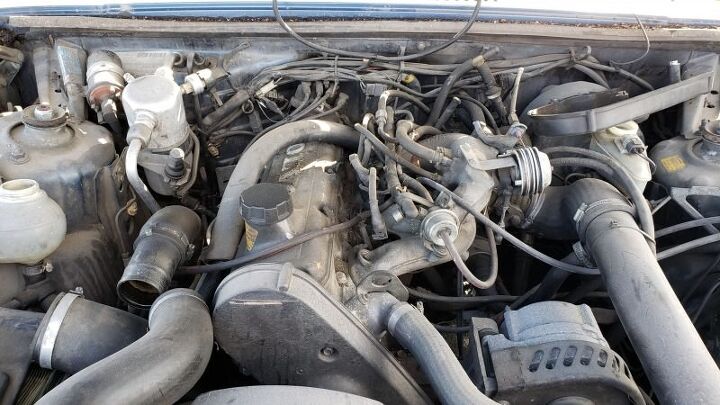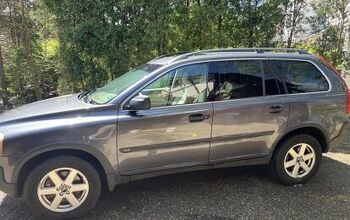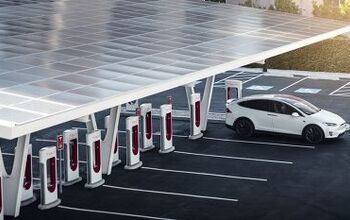Junkyard Find: 1990 Volvo 740 Turbo With Nearly 500,000 Miles

One of the frustrating things about my job looking for interesting discarded vehicles is the fact that most cars and light trucks didn’t start getting six-digit odometers until the 1980s or even the 1990s. I find vehicles that I know must have racked up incredible total mileage figures, but their odometers all turned over (once? ten times?) when they got past 99,999 miles.
Fortunately, Volvo felt sufficiently optimistic to adopt the six-digit odometer way back in the 1960s, so I was able to read a very impressive figure on the one in this 740 wagon: 493,549 miles.
Yes, that’s close to 16,500 miles every year for its three-decade lifespan. I’ve found a Mercedes-Benz W201 with better than 600,000 miles and a Volkswagen Rabbit Cabrio showing a not-sure-I-believe-it 930,013 miles, plus lots and lots of junked Hondas and Toyotas (and one Oldsmobile) with readings of close to 400,000 miles, but this Volvo in the San Francisco Bay Area ranks near the top of the longevity sweepstakes.
One thing I’ve found with extreme-high-mile junkyard cars is that most of them were in decent cosmetic shape when they finally wore out (or, more likely, were traded in and then proved radioactively unsaleable at auction). That makes sense, because the kind of vehicle owner who takes care of all the maintenance over multiple decades also takes good care of the body and interior. A nasty hooptie with a shredded interior tends to get thrown out when something mechanical costing more than a couple of hundred bucks fails. Looking at this car, I’d have guessed it had perhaps 150,000 miles, not three times that. I see this phenomenon often with high-mile junkyard (rear-wheel-drive) Volvos.
The turbocharged engine is a bit of a surprise, though, because cars with forced induction run hotter, blow head gaskets more readily, and generally get hooned on harder than their naturally-aspirated counterparts.
Perhaps the automatic transmission served to keep the drivers of this car from getting too lead-footed with that 162-horse turbo motor.
To a radar gun, it looked exactly like a Porsche 944… though I’ll bet the brick shape of the Volvo made it detectable at a longer range.
For links to 1,800+ more posts like this one, head to the Junkyard Home of the Murilee Martin Lifestyle Brand™.

Murilee Martin is the pen name of Phil Greden, a writer who has lived in Minnesota, California, Georgia and (now) Colorado. He has toiled at copywriting, technical writing, junkmail writing, fiction writing and now automotive writing. He has owned many terrible vehicles and some good ones. He spends a great deal of time in self-service junkyards. These days, he writes for publications including Autoweek, Autoblog, Hagerty, The Truth About Cars and Capital One.
More by Murilee Martin
Latest Car Reviews
Read moreLatest Product Reviews
Read moreRecent Comments
- Master Baiter I told my wife that rather than buying my 13YO son a car when he turns 16, we'd be better off just having him take Lyft everywhere he needs to go. She laughed off the idea, but between the cost of insurance and an extra vehicle, I'd wager that Lyft would be a cheaper option, and safer for the kid as well.
- Master Baiter Toyota and Honda have sufficient brand equity and manufacturing expertise that they could switch to producing EVs if and when they determine it's necessary based on market realities. If you know how to build cars, then designing one around an EV drive train is trivial for a company the size of Toyota or Honda. By waiting it out, these companies can take advantage of supply chains being developed around batteries and electric motors, while avoiding short term losses like Ford is experiencing. Regarding hybrids, personally I don't do enough city driving to warrant the expense and complexity of a system essentially designed to recover braking energy.
- Urlik You missed the point. The Feds haven’t changed child labor laws so it is still illegal under Federal law. No state has changed their law so that it goes against a Federal child labor hazardous order like working in a slaughter house either.
- Plaincraig 1975 Mercury Cougar with the 460 four barrel. My dad bought it new and removed all the pollution control stuff and did a lot of upgrades to the engine (450hp). I got to use it from 1986 to 1991 when I got my Eclipse GSX. The payments and insurance for a 3000GT were going to be too much. No tickets no accidents so far in my many years and miles.My sister learned on a 76 LTD with the 350 two barrel then a Ford Escort but she has tickets (speeding but she has contacts so they get dismissed or fine and no points) and accidents (none her fault)
- Namesakeone If I were the parent of a teenage daughter, I would want her in an H1 Hummer. It would be big enough to protect her in a crash, too big for her to afford the fuel (and thus keep her home), big enough to intimidate her in a parallel-parking situation (and thus keep her home), and the transmission tunnel would prevent backseat sex.If I were the parent of a teenage son, I would want him to have, for his first wheeled transportation...a ride-on lawnmower. For obvious reasons.













































Comments
Join the conversation
These went from essentially everywhere in the early 2010s to non existent in the late 2010s
The overall shape of this vehicle appeals to me very much. Minor issues: - The tailpipe is way wrong. - The clock does not deserve equal billing with the speedometer and tachometer. [This vehicle burned something like $50,000 worth of gasoline over its lifetime.]